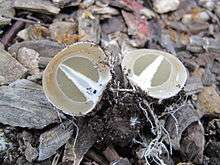Phallus rubicundus
Phallus rubicundus is a species of fungus in the stinkhorn family. First described in 1811, it has a wide distribution in tropical regions. It has the typical stinkhorn structure consisting of a spongy stalk up to 15 cm (5.9 in) tall arising from a gelatinous "egg" up to 3 cm (1.2 in) in diameter. Atop the stalk is a pitted, conical cap that has a foul-smelling, gelatinous, green spore mass spread over it.
Taxonomy
The species was first described under the name Satyrus rubicundus by French botanist Louis Augustin Guillaume Bosc in 1811,[2] from collections made in South Carolina.[3] It was later transferred to the genus Phallus in 1823 by Elias Fries.[4] Synonyms include binomials resulting from the transfer to Ithyphallus by Eduard Fischer in 1888, and to Leiophallus by Émile-Victor Mussat in 1900.[1]
Description

Immature (unopened) specimens of Phallus rubicundus are spherical to egg-shaped, whitish, and measure 2–3 cm (0.8–1.2 in) long by 1–3 cm (0.4–1.2 in) wide. They occur singly or in groups of two to six eggs that are formed from a common mycelium.[5] They are attached to the substrate by a cordlike rhizomorph. After expanding, the fruit bodies are up to 15 cm (5.9 in) tall, and consist of a hollow cylindrical stalk supporting a conical to bell-shaped cap. The orange to scarlet stalk tapers towards to top, and has a pitted surface.[6] The wrinled cap is scarlet red, and measures 2–3 cm (0.8–1.2 in) high by 1–2 cm (0.4–0.8 in) wide. It is initially covered with a foetid, slimy grayish-olive gleba.[6] The egg case remains at the base of the stalk as a volva.[7] The spores are smooth, elliptical, and measure 3.6–4.2 by 1.6–2.0 μm.[6]
Phallus rubicundus is often confused with the similar Mutinus elegans, but the latter species does not have a clearly separated cap, and instead bears its gleba on the apex of its pointed stalk.[3]
Uses
In the Indian state of Madhya Pradesh, where it is known locally asjhiri pihiri, it is used by two primitive forest tribes, the Bharia and the Baiga, as a treatment against typhoid, and also by the Baiga to treat labour pain. The fungus is prepared by grinding and mixing with sugar-cake, and one teaspoon is administered three times daily.[8] The fungus has been reported to have been used by Aboriginal Australians as an aphrodisiac.[9]
One study noted that mosquitoes, attracted to the smell of the gleba, perish after consuming it, and so the fungus may be suitable for further investigating as a biocontrol agent.[10]
Ecology and distribution
The fungus is saprobic, and grows in sandy soils, lawns, gardens, and yards, especially those that are well-manured or use wood mulch. It is widely distributed in southern and eastern United States (including Hawaii[7]), having possibly been spread through the use of imported wood mulch in landscaping.[3] In Australia it grows mainly in the tropics and subtropics, in areas where rotten wood and/or mulch are present.[11] In Asia, it has been recorded from China,[12] Japan,[13] Korea,[14] India,[8] and Thailand.[15] African locales include Ghana, Nigeria,[16] Congo, Kenya,[17] and South Africa.[6] It is also known from South America (Argentina[18] and Brazil[19]) and the Caribbean.[6] The fungus was featured on a Sierra Leonean postage stamp in 1993.[20]
References
- 1 2 "Phallus rubicundus (Bosc) Fr. 1823". MycoBank. International Mycological Association. Retrieved 2012-10-02.
- ↑ Bosc L. (1811). "Mémoire sur quelques espèces de Champignons des parties méridionales de l'Amérique septentrionale". Magazin der Gesellschaft Naturforschenden Freunde Berlin (in French). 5: 86, t. 6:8.
- 1 2 3 Kuo M. (April 2011). "Phallus rubicundus". MushroomExpert.com. Retrieved 2012-10-02.
- ↑ Fries EM. (1823). Systema Mycologicum (in Latin). 2. Greifswald, Germany: Sumtibus Ernesti Mauritii. p. 284.
- ↑ Long WH. (1907). "The Phalloideae of Texas". Journal of Mycology. 13 (3): 102–14. doi:10.2307/3752841.
- 1 2 3 4 5 Dissing H, Lange M (1962). "Gasteromycetes of Congo". Bulletin du Jardin botanique de l'État a Bruxelles. 32 (4): 325–416 (see pp. 328–9). JSTOR 3667249.
- 1 2 Hemmes DE, Desjardin D (2002). Mushrooms of Hawai'i: An Identification Guide. Berkeley, California: Ten Speed Press. p. 40. ISBN 1580083390.
- 1 2 Rai BK, Ayachi SS, Arvinder R (1993). "A note on ethno-myco-medicines from central India". Mycologist. 7 (4): 192–3. doi:10.1016/S0269-915X(09)80397-2. ISSN 0269-915X.
- ↑ Cambie RC, Brewis A (1997). Anti-Fertility Plants of the Pacific. Collingwood, Australia: Csiro Publishing. p. 21. ISBN 978-0-643-05986-3.
- ↑ Gardezi RA. (1992). "The fungus Phallus rubicundus: Possible attractant and bio-control agent for mosquitoes". Pakistan Journal of Scientific and Industrial Research. 35 (10): 409–10. ISSN 0030-9885.
- ↑ Fuhrer B. (2005). A Field Guide to Australian Fungi. Melbourne, Australia: Bloomings Books. p. 139. ISBN 1-876473-51-7.
- ↑ Huang N-L. (1985). "Notes on Phallales from Fujian China". Wuyi Science Journal (in Chinese). 5: 211–8. ISSN 1001-4276.
- ↑ Kasuya T, Takehashi S, Sanjyo K (2007). "Three species of the genus Phallus rediscovered in Japan". Nippon Kingakukai Kaiho (in Japanese). 48 (2): 44–56. ISSN 0029-0289.
- ↑ Wojewoda W, Heinrich Z, Komorowska H (1993). "Macromycetes Korei Północnej" [Macrofungi of North Korea]. Wiadomosci Botaniczne (in Polish). 37 (3–4): 125–8. ISSN 0043-5090.
- ↑ Ellingsen H-J. (1982). "Some Gasteromycetes from northern Thailand". Nordic Journal of Botany. 2 (3): 283–6. doi:10.1111/j.1756-1051.1982.tb01190.x.
- ↑ Dring DM, Rose AC (1977). "Additions to West African phalloid fungi". Kew Bulletin. 31 (3): 741–51. doi:10.2307/4119427.
- ↑ Williams RS. (1991). "A fungi safari in Kenya". Mycologist. 5 (3): 141–5. doi:10.1016/S0269-915X(09)80310-8.
- ↑ De Toledo LD. (1995). "Gasteromycetes (Eumycota) from central and western Argentina: II. Order Phallales". Darwiniana (San Isidro) (in Spanish). 33: 195–210. ISSN 0011-6793.
- ↑ Bonini VL, Guzman G, Capelari M (1984). "Basidiomycetes from the Parque Estadual da Ilha do Cardoso Brazil 5. Gasteromycetes". Rickia (in Portuguese). 11: 91–8. ISSN 0080-3014.
- ↑ Moss MO. (1998). "Gasteroid Basidiomycetes on postage stamps". Mycologist. 12 (3): 104–6. doi:10.1016/S0269-915X(98)80005-0.
